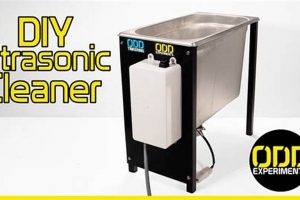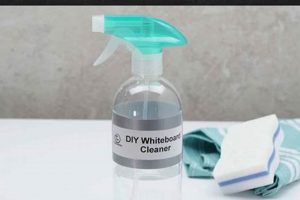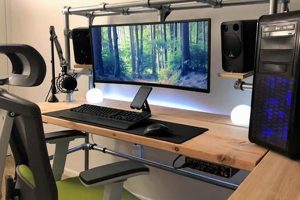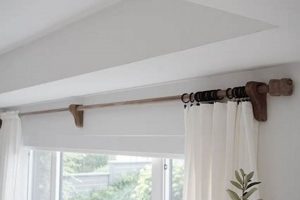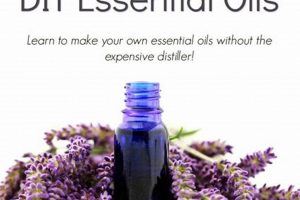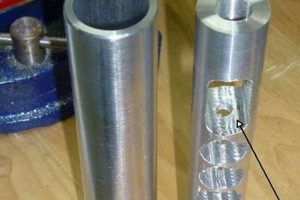Constructing a custom habitat for reptilian companions, often undertaken as a weekend project, allows for the creation of a space precisely tailored to the specific needs of the inhabitant. These habitats can range from modified furniture to entirely scratch-built structures, utilizing materials such as wood, glass, and acrylic. For example, a repurposed bookshelf can be transformed into a suitable dwelling for a small snake or lizard, incorporating appropriate ventilation, heating, and lighting fixtures.
The creation of these personalized environments offers several advantages. Foremost is the ability to control environmental parameters, ensuring optimal temperature gradients, humidity levels, and light cycles, which are crucial for the health and well-being of reptiles. Furthermore, building a custom habitat allows for cost savings compared to purchasing pre-made enclosures, particularly for larger or specialized species. Historically, these bespoke constructions have been a necessity for reptile keepers seeking to provide adequate housing for their animals, predating the wide availability of commercially produced enclosures.
This exploration will delve into the planning, design considerations, material selection, and construction techniques involved in building a suitable dwelling. Attention will be given to ensuring safety and security for both the reptile and the keeper. Further sections will cover appropriate heating, lighting, and substrate choices, as well as methods for enriching the environment to promote natural behaviors and reduce stress.
Tips for a Custom-Built Reptilian Habitat
The construction of a custom habitat requires meticulous planning and execution to ensure the reptile’s safety, security, and well-being. The following tips offer guidance on key aspects of the construction process.
Tip 1: Comprehensive Research is Essential: Prior to commencing construction, thoroughly research the specific environmental needs of the intended inhabitant. This includes temperature requirements, humidity levels, lighting needs (UVB and UVA), appropriate substrate, and space considerations based on the reptile’s adult size.
Tip 2: Prioritize Material Safety: Select materials that are non-toxic, durable, and resistant to moisture. Untreated wood should be sealed with a reptile-safe sealant to prevent rot and the leaching of harmful chemicals. Avoid using pressure-treated wood, which contains chemicals potentially harmful to reptiles.
Tip 3: Ensure Adequate Ventilation: Proper ventilation is crucial for maintaining air quality and preventing the buildup of humidity and harmful gases. Strategically place vents to promote cross-ventilation without creating drafts that could negatively impact temperature gradients.
Tip 4: Implement Secure Locking Mechanisms: Design and implement secure locking mechanisms for doors and access panels to prevent escapes. Reptiles are adept at finding weaknesses in enclosures, so choose robust latches and hinges.
Tip 5: Incorporate Appropriate Heating and Lighting: Carefully select and install heating and lighting fixtures that meet the reptile’s specific needs. Use thermostats and timers to regulate temperature and light cycles, mimicking natural environmental conditions. Ensure proper placement to avoid burns or overheating.
Tip 6: Optimize Substrate Selection: Choose a substrate that is appropriate for the reptile’s species and environmental needs. Consider factors such as humidity retention, ease of cleaning, and digestibility (to minimize impaction risk if ingested). Avoid substrates that may be dusty or contain harmful chemicals.
Tip 7: Consider Enrichment Strategies Early: Planning for enrichment from the start ensures a more stimulating and natural environment for the reptile. Design and incorporate ledges, climbing branches, hiding spots, and water features into the habitat’s layout. Position these features strategically to optimize their use and promote natural behaviors.
Adhering to these guidelines ensures that the custom-built habitat will provide a safe, healthy, and enriching environment, tailored precisely to the requirements of its reptilian occupant. Careful planning and execution contribute directly to the long-term well-being of the animal.
The following sections will elaborate on specific design and construction techniques for building a secure and functional enclosure.
1. Species-Specific Needs
The correlation between a reptile’s unique biological and behavioral characteristics and the design of its enclosure represents a critical determinant of its well-being within a captive environment. This is especially pertinent when constructing a customized habitat, where the opportunity exists to precisely address those individual needs. Failure to account for species-specific requirements when planning a habitat can result in physiological stress, behavioral abnormalities, and an increased susceptibility to disease. For instance, an arboreal reptile, such as a crested gecko, requires a vertically oriented enclosure with ample climbing opportunities, while a terrestrial species like a leopard gecko needs a horizontally oriented space with readily accessible hides. The dimensions of the habitat, the type of substrate used, the provision of appropriate thermal gradients, and the availability of essential environmental elements directly influence the reptile’s ability to thrive.
Real-world examples underscore the practical significance of understanding these species-specific needs. Consider the implications of housing a snake species that naturally inhabits arid environments in an enclosure with excessively high humidity. This mismatch can lead to skin infections, respiratory problems, and a general decline in health. Conversely, providing a rainforest-dwelling reptile with insufficient humidity can result in dehydration, shedding difficulties, and compromised immune function. Furthermore, the appropriate provision of UVB lighting is essential for diurnal reptiles that require it for vitamin D3 synthesis, calcium absorption, and overall bone health. An inadequate UVB source can lead to metabolic bone disease, a debilitating and potentially fatal condition. Therefore, a comprehensive understanding of the specific species is not merely a recommendation but a prerequisite for ethical and responsible reptile keeping.
In summary, recognizing and meticulously addressing the species-specific needs of a reptile is paramount when undertaking a custom enclosure project. This involves thorough research into the animal’s natural history, habitat preferences, and physiological requirements. Prioritizing these considerations throughout the planning and construction phases ensures that the resultant habitat promotes the reptile’s health, security, and psychological well-being. While challenges may arise in replicating a natural environment perfectly, a dedicated effort to meet the reptile’s intrinsic needs will contribute to its long-term survival and quality of life in captivity.
2. Material Safety
The selection of appropriate materials represents a foundational aspect of constructing a reptile enclosure. The inherent properties of chosen materials directly influence the health and safety of the inhabitant. Improper material selection can lead to chronic exposure to toxins, physical injury, and compromised environmental conditions.
- Toxicity Considerations
Certain materials, commonly employed in general construction, may contain substances harmful to reptiles. Treated lumber, for example, often contains preservatives designed to resist rot and insect infestation, but these chemicals can leach into the enclosure environment, posing a significant health risk to reptiles through direct contact or inhalation. Similarly, paints, adhesives, and sealants may release volatile organic compounds (VOCs) that can irritate the respiratory system or be absorbed through the skin. Selecting reptile-safe alternatives, such as water-based paints and silicone sealants certified as non-toxic after curing, is crucial to mitigate these risks.
- Structural Integrity and Durability
The chosen materials must possess sufficient structural integrity to withstand the forces exerted by the reptile and the environmental conditions within the enclosure. Glass, acrylic, and wood, if properly selected and assembled, can provide a durable and secure structure. However, using excessively thin glass or poorly constructed wooden frames can lead to structural failure, potentially resulting in injury to the reptile or escape. Furthermore, the material’s resistance to moisture and degradation is essential, particularly in enclosures designed for species requiring high humidity levels. Materials prone to rot or corrosion can compromise the enclosure’s structural integrity and release harmful byproducts.
- Surface Properties and Cleanliness
The surface properties of materials used within the enclosure affect the ease of cleaning and disinfection, which are critical for maintaining a hygienic environment. Porous materials, such as untreated wood or rough concrete, can harbor bacteria and parasites, making them difficult to sanitize effectively. Smooth, non-porous surfaces, like glass or sealed acrylic, are easier to clean and disinfect, reducing the risk of pathogen buildup. Additionally, the texture of the surface can impact the reptile’s ability to move and interact with its environment. Abrasive or sharp surfaces can cause skin abrasions or injuries, while smooth, slippery surfaces can hinder locomotion.
- Thermal Properties and Insulation
The thermal properties of the selected material affect its ability to maintain a stable temperature gradient within the enclosure. Materials with high thermal conductivity, such as metal, can quickly transfer heat, potentially creating hot spots or cold spots within the enclosure. Insulating materials, such as wood or certain types of rigid foam, can help to maintain a consistent temperature and reduce energy consumption. Careful consideration of the material’s thermal properties is essential for creating a thermal gradient appropriate for the specific reptile species.
These factors are not merely aesthetic considerations, but critical determinants of the reptile’s long-term health and well-being. Prioritizing material safety throughout the design and construction process is paramount for ensuring a secure and healthy environment.
3. Ventilation and Airflow
Ventilation and airflow represent critical environmental control parameters within a reptile enclosure. Inadequate ventilation can lead to the accumulation of harmful gases, excessive humidity, and the proliferation of pathogens, directly impacting the health and well-being of the reptile. A carefully designed system that promotes sufficient airflow is essential, particularly within habitats created through do-it-yourself (DIY) projects.
- Gas Exchange and Air Quality
Reptiles, like all animals, require oxygen for respiration and produce carbon dioxide as a metabolic waste product. Within a poorly ventilated enclosure, carbon dioxide levels can rise, leading to respiratory distress and potential long-term health consequences. Additionally, the decomposition of organic matter, such as uneaten food and waste, generates ammonia and other noxious gases. These gases can irritate the respiratory tract and mucous membranes, increasing susceptibility to infection. Adequate ventilation facilitates the exchange of stale air with fresh air, maintaining oxygen levels and minimizing the buildup of harmful gases. For instance, strategically placed vents on opposite sides of an enclosure create a natural convection current, promoting efficient air exchange. Insufficient air quality can lead to upper respiratory infections (URI), a common ailment in captive reptiles, highlighting the direct link between ventilation and health.
- Humidity Control
Maintaining appropriate humidity levels is crucial for many reptile species, but excessive humidity can create an environment conducive to fungal and bacterial growth. Poor ventilation exacerbates this issue by trapping moisture within the enclosure. Conversely, excessive ventilation in an environment that requires high humidity can dry out the substrate and the reptile. Proper airflow helps to regulate humidity by removing excess moisture while still maintaining the necessary levels for the species housed. A well-ventilated enclosure also allows for spot-cleaning to be more effective; the fresh air helps to dry out the cleaned spot and prevent bacteria and mold from growing. The balance of humidity levels and airflow is very delicate and requires careful monitoring.
- Temperature Regulation
Ventilation plays a role in the regulation of temperature gradients within the enclosure. While heating elements provide localized heat sources, airflow helps to distribute heat more evenly, preventing the formation of extreme hot spots or cold spots. Cross-ventilation, for example, can assist in dissipating heat from basking areas, preventing overheating. The strategic placement of vents can also influence the direction and intensity of airflow, allowing for fine-tuning of the temperature gradient to meet the specific requirements of the reptile. However, in extremely cold climates or reptile species that require high temperature it is important to be mindful of the outside air temperature, to prevent sudden or drastic cooling of the enclosure.
- Pathogen Control
Stagnant air promotes the growth of bacteria, fungi, and other pathogens that can cause disease in reptiles. Adequate ventilation helps to reduce the concentration of airborne pathogens, minimizing the risk of infection. Airflow also promotes the drying of surfaces, inhibiting the growth of microorganisms. Furthermore, ventilation aids in the removal of dust and debris, reducing the availability of nutrients for pathogens. In a DIY enclosure, this necessitates careful consideration of vent placement and size to ensure effective airflow without compromising other environmental parameters. Without proper ventilation, bacteria will grow quickly and spread throughout the entire enclosure. A clean environment, ventilation, and proper humidity will prevent these issues from occurring.
Therefore, ventilation is not simply a matter of providing fresh air, but an integral component of maintaining a healthy and balanced environment. Thoughtful design and imp
lementation are essential when constructing DIY reptile enclosures to ensure proper air quality, humidity control, temperature regulation, and pathogen control. Failure to address these considerations can have significant and detrimental consequences for the reptile’s health and well-being. The selection of ventilation techniques must address all of these issues in order to maintain a thriving habitat.
4. Secure Containment
Secure containment is a paramount consideration in any reptile enclosure, but it assumes heightened importance in the context of “diy reptile enclosure.” The inherent variability in design and construction inherent in DIY projects necessitates a thorough understanding of potential escape points and preventative measures.
- Material Selection and Joint Integrity
The choice of materials significantly influences the structural integrity of the enclosure and its ability to prevent escape. Weak or poorly joined materials can create vulnerabilities. For instance, using thin acrylic panels secured with insufficient adhesive may allow a reptile to push its way through a seam. Conversely, robust materials like thick glass or solid wood, properly joined with strong mechanical fasteners and reptile-safe sealant, offer a more secure barrier. The integrity of every joint, seam, and corner must be meticulously assessed to prevent even small gaps that a determined reptile might exploit.
- Lid and Door Mechanisms
Access points such as lids and doors represent common areas of compromise in enclosure security. Simple gravity-fed lids or loosely fitting doors can be easily displaced by reptiles, particularly larger or more active species. Secure locking mechanisms, such as latches, hasps, or sliding bolt locks, are essential. These mechanisms must be robust enough to withstand the reptile’s attempts to manipulate or force them open. Furthermore, hinges should be securely attached and reinforced to prevent them from being pulled out or broken. A combination of multiple security measures at each access point further reduces the risk of escape.
- Ventilation Security
Ventilation is necessary for maintaining proper air quality within the enclosure, but improperly designed or secured ventilation openings can provide escape routes. Vents should be covered with a fine mesh or perforated material that prevents the reptile from squeezing through. The mesh or perforated material must be securely attached to the enclosure to prevent it from being dislodged. The size of the openings should be carefully considered to ensure adequate ventilation without compromising security. For smaller reptiles, even seemingly small gaps can provide an avenue for escape.
- Substrate Management
The level and type of substrate used within the enclosure can indirectly impact security. A substrate level that is too high can allow a reptile to reach the top of the enclosure and potentially push against the lid or other access points. Choosing a substrate that is easily burrowed into can also create a risk if the reptile is able to burrow underneath the walls of the enclosure. The type of substrate is also something to consider. Some substrates hold moisture and promote mold or break down the sealant, causing it to crumble, making the enclosure less secure.
Addressing these facets within the design and construction of a “diy reptile enclosure” is vital. While commercial enclosures undergo standardized testing for security, DIY projects rely entirely on the knowledge, skill, and diligence of the builder to ensure effective containment. Failure to prioritize secure containment can result in escapes, posing a threat to the reptile, the surrounding environment, and potentially leading to legal repercussions in areas where certain reptile species are regulated.
5. Thermal Gradient
A thermal gradient, characterized by a range of temperatures within an enclosure, is a fundamental requirement for the physiological well-being of reptiles. The provision of an appropriate temperature gradient is critical and often requires diligent planning and execution, particularly in self-constructed habitats.
- Importance of Behavioral Thermoregulation
Reptiles, being ectothermic, rely on external heat sources to regulate their body temperature. A thermal gradient allows the reptile to behaviorally thermoregulate, moving between warmer and cooler zones to achieve an optimal internal temperature for digestion, immune function, and other metabolic processes. For example, a basking area provides a focal point of high temperature, while a shaded area offers a cooler retreat. The gradient enables the reptile to self-select its preferred temperature, optimizing its physiological functions. The absence of this gradient forces the reptile to endure a uniformly warm or cool environment, leading to chronic stress, impaired immune function, and increased susceptibility to disease. In a DIY enclosure, careful planning is critical to the reptile’s well-being.
- Heat Source Selection and Placement
The selection and placement of heat sources are critical in establishing an appropriate thermal gradient within a DIY reptile enclosure. Options include heat lamps, ceramic heat emitters, and under-tank heaters. Heat lamps provide radiant heat, mimicking the sun, and are typically positioned over a designated basking area. Ceramic heat emitters produce heat without visible light and are suitable for nighttime use. Under-tank heaters provide conductive heat and are generally used as a supplemental heat source. The placement of these heat sources must create a distinct temperature differential, with one end of the enclosure significantly warmer than the other. Improper placement can result in a lack of gradient, negating the reptile’s ability to thermoregulate.
- Temperature Monitoring and Control
Accurate monitoring and control of temperatures within the enclosure are essential for maintaining the thermal gradient within safe and appropriate limits. Thermometers should be placed at various points within the enclosure, including the basking area and the cooler end, to provide a comprehensive overview of the temperature range. Thermostats are used to regulate the output of heat sources, preventing overheating and ensuring a stable temperature gradient. Regular monitoring and adjustment of temperature settings are necessary to accommodate seasonal changes and variations in ambient temperature. Without proper temperature monitoring and control, a thermal gradient can quickly become detrimental to the reptile’s health.
- Substrate Influence and Gradient Stability
The type and depth of substrate can influence the stability and effectiveness of the thermal gradient. Darker substrates absorb heat more readily than lighter substrates, potentially creating hot spots. Deep substrates can insulate the enclosure, reducing the temperature differential between the warm and cool ends. The substrate must be carefully selected and managed to complement the heat sources and maintain a consistent and appropriate thermal gradient. Regular turning or replacement of the substrate may be necessary to prevent the buildup of excessive heat or moisture, which can disrupt the gradient.
These factors, when considered within the context of “diy reptile enclosure,” highlight the complexities in
volved in replicating a natural thermal environment. While commercially available enclosures offer pre-engineered solutions, the design and construction of a DIY enclosure require a thorough understanding of reptilian thermoregulation and meticulous attention to detail. The successful creation of a thermal gradient is a critical determinant of the reptile’s long-term health and survival.
Frequently Asked Questions
This section addresses common inquiries regarding the construction of custom reptile habitats, providing clarity on crucial aspects of the process.
Question 1: What are the essential safety precautions when building a habitat from scratch?
The construction process necessitates several precautions. Selection of non-toxic materials is paramount. Adequate ventilation must be incorporated to prevent the buildup of harmful gases. Electrical wiring for lighting and heating must adhere to safety standards, mitigating the risk of fire or electrocution. Sharp edges or protrusions within the enclosure must be eliminated to prevent injury to the animal. Finally, ensure the structure can safely support the weight of substrate, water features, and the reptile itself.
Question 2: How does one determine the appropriate size for a habitat?
The size of the enclosure should be commensurate with the adult size and activity level of the reptile species. A general guideline suggests that the enclosure length should be at least three times the reptile’s adult body length, and the width should be at least two times its length. Arboreal species require vertically oriented enclosures with sufficient climbing space. Overcrowding can lead to stress, aggression, and health problems. Thorough research into the specific spatial requirements of the intended occupant is essential.
Question 3: Which materials are unsuitable for constructing a habitat?
Several materials present inherent risks and should be avoided. Treated lumber may leach harmful chemicals. Galvanized metal can release zinc, which is toxic to reptiles. Unsealed porous materials, such as untreated wood or concrete, harbor bacteria. Screen mesh comprised of materials can cause claw damage and breakage. Any material with sharp edges or splinters poses a physical hazard. Furthermore, materials that are difficult to clean and disinfect should be avoided to maintain a hygienic environment.
Question 4: What are the key considerations for ventilation?
Ventilation is crucial for maintaining air quality and regulating humidity. Vents should be strategically placed to promote cross-ventilation without creating drafts that could negatively impact temperature gradients. The size and number of vents should be adjusted based on the enclosure size and the reptile’s specific humidity requirements. Insufficient ventilation can lead to the buildup of harmful gases and the proliferation of pathogens, while excessive ventilation can result in dehydration. The balance between ventilation and humidity retention is paramount.
Question 5: How can one ensure the enclosure is escape-proof?
Secure containment is paramount. The enclosure must be constructed from sturdy materials with tight-fitting seams and secure closures. Lids and doors should be equipped with locking mechanisms that cannot be easily manipulated by the reptile. Ventilation openings must be covered with a fine mesh or perforated material that prevents escape. The perimeter of the enclosure should be regularly inspected for any potential weaknesses or gaps. Reptile species will relentlessly test the enclosure’s integrity.
Question 6: What are the recommended methods for heating and lighting the habitat?
Heating and lighting must mimic the reptile’s natural environment and provide a distinct thermal gradient. Heat lamps, ceramic heat emitters, and under-tank heaters are common heating options. UVB and UVA lighting are essential for diurnal reptiles, facilitating vitamin D3 synthesis and calcium absorption. Thermostats and timers should be used to regulate temperature and light cycles, preventing overheating and maintaining consistent environmental conditions. Incorrect placement or type of heat/light sources will cause harm to the reptile.
In summary, building a suitable habitat necessitates careful planning, meticulous construction, and a comprehensive understanding of the reptile’s specific needs. Addressing these frequently asked questions is essential for ensuring the animal’s health, safety, and well-being.
The following section delves into advanced design and construction techniques.
DIY Reptile Enclosure
This exploration has underscored the multifaceted considerations inherent in constructing custom habitats. From species-specific environmental needs and the imperative of material safety to the critical roles of ventilation, secure containment, and thermal gradients, each element contributes directly to the health, security, and well-being of the reptilian inhabitant. The absence of meticulous planning and execution in any of these areas carries significant consequences, potentially compromising the animal’s physiological and psychological state. A successful DIY reptile enclosure demands a commitment to thorough research, informed decision-making, and precise construction techniques.
The creation of a suitable and sustainable habitat extends beyond mere construction; it signifies a responsibility to provide optimal conditions for a captive animal. Continued learning, adaptation, and refinement of enclosure designs are crucial as knowledge of reptilian husbandry evolves. By prioritizing the animal’s needs above all else, constructors can ensure that custom-built enclosures serve as enriching and life-sustaining environments, promoting both the well-being of the reptile and the advancement of responsible herpetoculture.


